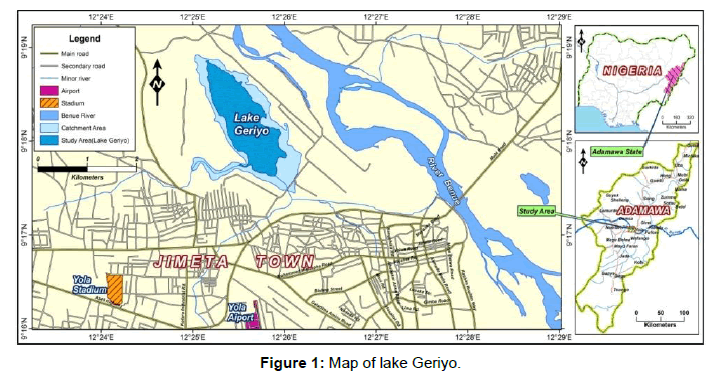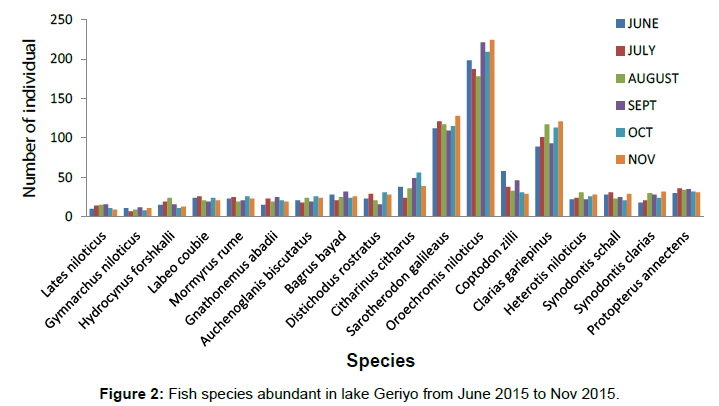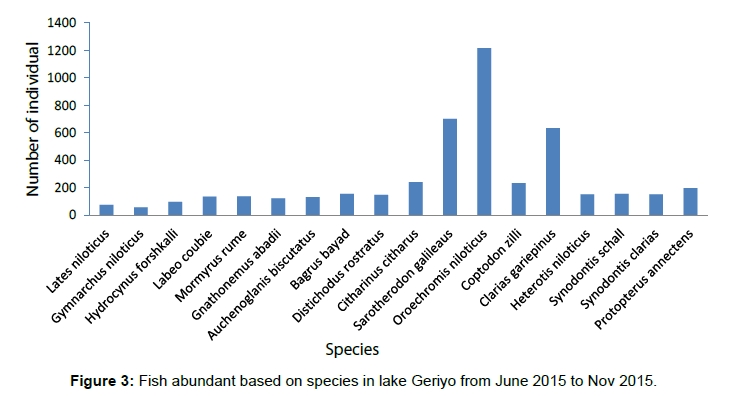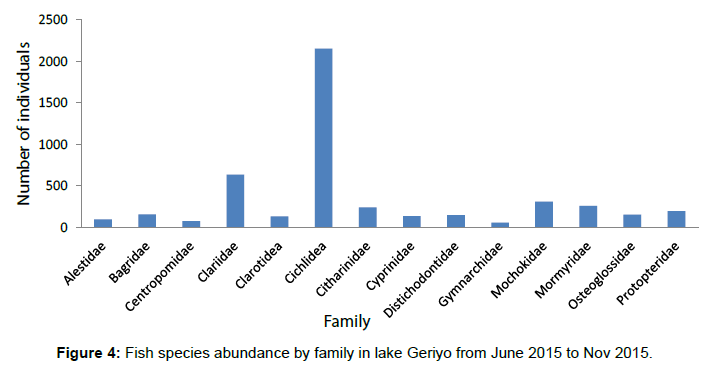Some Ichyofauna Status of Lake Geriyo, Adamawa State
Received: 27-Jun-2017 / Accepted Date: 02-Aug-2017 / Published Date: 10-Aug-2017 DOI: 10.4172/2332-2608.1000244
Abstract
The abundant and diversity of freshwater fishes of Lake Geriyo, was studied from June to November 2015. A total of eighteen freshwater fish species belonging to fourteen families were recorded. The fish abundance increases along the months with the highest abundant and lowest recorded in November and June, respectively while the diversity remains the same throughout the sampling period. Oreochromis niloticus was the most abundant species with 25.61% of the total fish sampled while Gymnarchus niloticus was the least abundant with 1.22%. The family Cichlidae was the most abundant (45.33%) which comprises of Oreochromis niloticus, Coptodon zilli and Sarotherodon galilaeus; and Gymnarchida (1.22%) been the least abundant family. The family Cichlidae is the most diversed group with three species followed by the family Mochokidae and Mormyridae with two species each. Fish diversity was assessed by calculating some biodiversity index such as Shannon-weiner index (H), Simpson’s Dominance Index (D) and Simpson’s index of diversity (1-D).
Keywords: Diversity; Lake geriyo; Biodiversity index; Freshwater fishes; Ichthyodiversity
Introduction
Ichthyodiversity refers to variety of fish species depending on the context and scale; it could refer to alleles or genotypes within piscian class to the species [1]. Fishes are the important elements in the economy of many nations as they have been a stable item in the diet of many people. These fish resources, apart from being a major source of high quality animal protein for man, it also provides several socioeconomic values as source of job opportunities and raw material for some industrial activities as well as recreational purposes [2]. Inland waters biodiversity constitute a valuable natural resource, in economic, cultural, aesthetic, scientific and educational terms; and are estimated to cover at least 14 million hectares [3] which are being fished by artisanal fishermen. Their conservation and management are critical to the interests of all human, nations and governments.
According to Ehrlich and Willson [4] the study of these biodiversity is essential for stabilization of ecosystem, protection of overall environmental quality for understanding intrinsic worth of all species on the earth. Biodiversity is the quantity, variety and distribution across biological scales ranging through genetics and life forms of populations, species, communities and ecosystems [5]. It is often used as a measure of the health status of the biological system. The streams and rivers are facing number of environmental problems throughout the world largely associated with anthropogenic activities in their catchment areas [6]. Also, habitat loss and environmental degradation causes rapid decline in biological diversity which is a critical challenge for the modern era [7]. Freshwater biodiversity is now in a state of crisis, a consequence of decades of human exploiting rivers with over fishing, pollution and development activities and Lake Geriyo, Adamawa state is not exempted from this crisis.
Lake Geriyo is one the man-made lake in Adamawa state Nigeria, originally formed as a flood plain area as a result of yearly over-flooding from the Upper Benue River. This Lake is also used for FADAMA farm irrigation purpose during the dry season. River conservation and management activities in most countries suffer from an inadequate knowledge of its biota constituents, especially in large, poorly investigated tropical river systems in Asian and African [8,9], tropical Australian [10] and Amazon regions [11]. The diversity of many water bodies have been investigated by different researchers which include Adeyemi et al. [12] on Gbedikere lake, Bassa, Kogi state; Lawson and Olusanya [13] on three tributaries of River Ore, Southwest, Nigeria; Ipinmoroti [14] on Asejire Lake; Dan-Kishiya et al. [15] on lower Usuma reservoir in Bwari; Adaka et al. [16] on Oramiri-Ukwa river, Southeast Nigeria, Abuja; Ekudayo et al. [17]on lake Geriyo, Adamawa state among others.
As Conservation and management planning begins with a comprehensive assessment of biodiversity which entails life histories, species richness, endemism, rarity, range of morphological and genetic variability, and evolutionary histories but the necessary first step is identification of the organisms [18]. Lake Geriyo, been an important source of livelihood not only to the artisanal fishers but to the community at large. Therefore, there is need for regular assessment of fish diversity, distribution and population towards proper monitoring, management and conservations so as to maintain and sustain the fisheries of this Lake.
Materials and Methods
Study area: Lake Geriyo is a flood plain lake, located at the outskirt of Jimeta metropolis Adamawa state on the North-East Nigeria. It lies between longitude 12°25’E and latitude 9°8’N (Figure 1). It is a shallow water body with a mean depth of about 2 meters and the mean annual rainfall of is between 900 and 1100 mm with the rainy season ranging from 150 to 160 days, usually from May to October. Temperature ranges from 20°C in December to January and intense heat with temperatures of 30°C to 42°C in March to April. It experiences some influx of waters from flood during rainy season and overflows from river Benue which serves as a major water source to the lake. The study region area is about 1,548 km2.
a) Collection of samples: Samples were collected once in a week from the landing site for the period of six (6) months, which extended from July to November, 2015. Fish species were caught with the assistance of local artisanal fishers using different types of nets namely: gill nets, cast nets, hook and line, local traps and bag nets of various sizes. The services of six (6) fishermen were explored during the collection periods. Collected fish samples were taking to the Department of Fisheries laboratory, Modibbo Adama University of Technology, Yola for proper identification. The fish samples were identified using the fish guide to freshwater fishes of Nigeria and field guide to Nigerian freshwater fishes.
Fish species diversity was subjected to diversity analysis using different indices like Shannon-Weiner index (H) [19]; Simpson Dominance index (D) and Simpson index of diversity (1–D) [9] (Figure 2).
b) Shannon-Weiner index: Species diversity was calculated following Shannon-Weiner index (H) which depends on both the number of species present and the abundance of each species
H =ΣPiLog2Pi
where, H=Shannon–Weiner index
Pi=ni/N
where
ni=Number of individuals of each species in the sample
N=Total number of individuals of all species in the sample
c) Simpson’s diversity indices: Simpson’s index (D) is a measure of diversity, which takes into account both species richness, and an evenness of abundance among the species present. In essence it measures the probability that two individuals randomly selected from an area will belong to the same species.

Where,
ni=Number of individuals of each species in the sample
N=Total number of individuals of all species in the sample
The value of D ranges from 0 to 1. With this index, 0 represents infinite diversity and, 1, no diversity. That is, the bigger the value the lower the diversity.
d) Simpson’s index of diversity (1–D). This is a reciprocal of the Simpson’s index of dominance and the value usually ranges between 0 and 1, which indicates that the greater the value, the greater the diversity of the sample area (Figure 3).
Results
A total of four thousand, seven hundred and fifty two (4752) individual fish samples were sampled from June to November which belong to eighteen (18) species and fourteen (14) families (Table 1). The lowest samples of fish species was recorded in the month of June while the highest was recorded in the month of November (Table 1). Oreochromis niloticus was the most abundant species during the sampling period which accounted for 1217 individuals and 25.61% of the total sampled species. Sarotherodon galileaus and Clarias gariepinus were next to O. niloticus in abundant with 702 (14.77%) and 634 (13.34%) individuals respectively (Table 1). Gymnarchus niloticus was the least abundant during the sampling period with 58 individuals and this accounted for 1.22% of the total sampled species and this was followed by Lates niloticus, 75 (1.58%) and Hydrocynus forshkalii, 98 (2.06%). The family Cichlidea has the highest composition with the three (3) species (Sarotherodon galileaus, Coptodon zilli and Oreochromis niloticus), followed by the family Mochokidae (Synodontis clarias and Synodontis schall) and Mormyridae (Mormyrus rume and Gnathonemus abadii) with two (2) species each. Fish species abundant by family showed that the family Cichlidae has the highest by number and percentage (2154; 45.33%). This is followed by the family Clarridae (634; 13.34%), Mochokidae (310; 6.52%), Mormyridae (255; 5.45%), Citharinidae (242; 5.09%) and Protopteridae (198; 4.17%). The least fish species abundant by family was found in the family Gymnarchidae (58; 1.22%) and followed by the family Centropomidae (75; 1.58%) and Alestidae (98; 2.06%) (Figure 4).
| Family | Species | Number of individuals | Per cent |
|---|---|---|---|
| Alestidae | Hydrocynus forshkalli | 98 | 2.06 |
| Bagridae | Bagrus bayad | 156 | 3.28 |
| Centropomidae | Lates niloticus | 75 | 1.58 |
| Clariidae | Clarias gariepinus | 634 | 13.34 |
| Clarotidae | Auchenoglanis biscutatus | 132 | 2.78 |
| Cichlidae | Sarotherodon galileaus | 702 | 14.77 |
| Oroechromis niloticus | 1217 | 25.61 | |
| Coptodon zilli | 235 | 4.95 | |
| Citharinidae | Citharinus citharus | 242 | 5.09 |
| Cyprinidae | Labeo coubie | 135 | 2.88 |
| Distichodontidae | Distichodus rostratus | 148 | 3.11 |
| Gymnarchidae | Gymnarchus niloticus | 58 | 1.22 |
| Mochokidae | Synodontis schall | 157 | 3.3 |
| Synodontis clarias | 153 | 3.22 | |
| Mormyridae | Mormyrus rume | 137 | 2.9 |
| Gnathonemus abadii | 122 | 2.57 | |
| Osteoglossidae | Heterotis niloticus | 153 | 3.22 |
| Protopteridae | Protopterus annectens | 198 | 4.17 |
| Total | 4752 | 100.0 |
Table 1: The composition, abundance and diversity of fish species sampled from lake Geriyo.
It was observed from the result that the month of June recorded the least number of fish sampled (763 fish individuals) while November had the highest with 835 fish individuals.
The diversity indices of the studied area showed a Shannon-Weiner (H) value of 2.483 while the Simpson’s Dominant (D) and Simpson’s index (1-D) were 0.1211 and 0.8789, respectively.
Discussion
The Fish species composition of Lake Geriyo revealed a fair higher species diversity of eighteen (18) species from fourteen (14) families compared to eleven (11) species from the three tributaries of River Ore Southwest Nigeria [13], twelve species from Gbedikere lake, Bassa, Kogi State [12] and eleven (11) species from lower Usuma reservoir in Bwari, Abuja [15]. But not as rich in diversity as that Asejire lake, Southwest Nigeria with twenty-seven (27) species [14] and that of Oramiri-Ukwa river, Southeast Nigeria with twenty-five (25) species [16]. The eighteen (18) species recorded in this present study were higher than the 14 species observed by Ekundayo et al. [17] from the same water body. This could be as a result of frequent inflow of water from the Upper Benue River to the Lake which may have periodically introduced new fish species to the lake from time to time. Though, a particular species (Malapterurus electricus) was reported by Ekundayo et al. [17] which was not found in this present study and that could be attributed to the species not susceptible to the gears used as earlier documented by Ipinmoroti [14]. The most abundant species were from the family Cichlidae (O. niloticus and S. galileaus) which were higher in each of the sampling period months. This showed a typical dominance tendency of the tilapiine cichlids in every environment they inhabit. This also follows the trend of results observed by Olawusi- Peters [20] in Agboyin Creek, Lagos State and by Ipinmoroti [14] in Asejire Lake. This could be attributed to the prolific and spontaneous breeding habit of the species from this family. The species from this family are known for their easy widespread even in area where they are not native or historically an important component of the catch [1]. Clarias gariepinus was next in abundant after O. niloticus and S. galileaus which had 13.34% of the total compositions. This was similar to the findings of Adeyemi et al. [12] which recorded 13.16% of the total composition of fish observed in Gbedikere Lake, Bassa, Kogi State. The least composition of Gymnarchus niloticus (1.22%) and Lates niloticus (1.58) observed in this study may be an indication that these two species are threatened in this lake or overfished. Due to their ability to grow big and their high price values, fishers have been known to hunt for them and this could explain why their compositions have reduced over time as documented by Peter et al. [21]. The low quantities of fish recorded in the months of June, July and August could be as a result of high fishing efforts in the Lake during these months while the fishing efforts fairly reduced in the month of October and November as the lake usually exercise partially closed season between November and April [22].
The diversity index, Shannon-Weiner (2.483) indicated a fair fish species diversity in the study area. The diversity using Simpson’s index of Dominance (D) (0.1211), indicated high species diversity as the value usually ranges from 0 to 1 and 0 represent infinite diversity while 1 represent no diversity. That is the larger the value of D the lower the diversity [13].
Also, the Simpson’s index of diversity (0.8789) showed a very fair diversity in the studied area as it usually ranges from 0 to 1 with greater value indicating greater diversity. This index suggests the probability that every two individual fish samples that is randomly selected from the studied area will belong to different species.
This study could serve as awareness in assisting relevant bodies in the management and conservation of fisheries resources of this lake and the nation at large in the need for quick intervention to rescue these threatened fish species. Also, external factors that are known to affect the population of freshwater species which include habitat loss as a result of withdrawal of water for human usage and irrigations should be addressed. Enactment and enforcement of laws and orders by regulating agencies in the management and conservation of the resources of natural waters should be considered a top priority and the partially closed season that is been exercise in this lake should be made complete close season so as to allow the fish species to re-stock themselves.
References
- Burton PJ, Balisky AE, Coward LP, Cumming SG, Kneeshaw DD (1992) The value of managing for biodiversity. The Forestry Chronicle 68: 225-237.
- Yakub AS (2012) A Survey of Fish fauna of lower Ogun Rivers at Ishasi, Ogun State, Western Nigeria. Continental Journal Fisheries and Aquatic Science 6: 1-7.
- Omorinkoba WS, Ogunfowora OO, Ago ND, Mshelia MB (2011) Artisanal fisheries activities in Lake Kainji. In: Forty years on Lake Kainji Fisheries Research, Raij A, Okaeme AN, Ibeun MO editors. 43-53.
- Ehrlich PR, Wilson EO (1991) Biodiversity studies. Science and Policy 253: 758-762.
- Mace G, Masundire H, Baillie J, Ricketts T, Brooks T (2005) Biodiversity. In: Hasan R, Scholes R, Ash N editors. Ecosystems and Human Well-Being Current State and Trends Island: 77-122.
- Young R, Townsend C, Mathaei C (2004) Functional indicators of river ecosystem health result- from regional case studies of leaf decomposition. An interim Guide.
- Vyas V, Damde V, Parashar V (2012) Fish Biodiversity of Betwa River in Madhya Pradesh India with special reference to a sacred Ghat. International Journal of Biological Conservation 4: 71-77.
- Dudgeon D (2000) The ecology of tropical Asian rivers and streams in relation to biodiversity conservation. Annual Review of Ecology and Systematics 31: 239-263.
- Shrestha TK (2003) Conservation and management of fishes in the large Himalayan Rivers of Nepal. Paper presented to the Second International Symposium on the Management of Large Rivers for Fisheries.
- Pusey BJ (1998) Methods addressing the flow requirements of fish. In: AH Arthington, JM Zalucki editors. Comparative evaluation of environmental flow assessment techniques Review of methods LWRRDC Occasional Paper Series 27/98 Canberra Land and Water Resources R & D Corporation 66-105.
- Saint-Paul U (2003) Fisheries ecology of Amazonian inundated forests. Paper presented to the Second International Symposium on the Management of Large Rivers for Fisheries 49.
- Adeyemi SO, Akombu PM, Adikwu IA (2010) Diversity and abundance of fish species in Gbedikere Lake, Bassa, Kogi State. Journal of Research in Forestry, Wildlife and Environment 2: 1-6.
- Lawson OE, Olusanya OM (2010) Fish Diversity in Three Tributaries of River Ore, South West, Nigeria. World Journal of Fish and Marine Sciences 2: 524-531.
- Ipinmoroti MO (2013) Ichthyofauna diversity of Lake Asejire Ecological Implications. International Journal of Fisheries and Aquaculture 5: 248-252.
- Dan-kishiya AS, Olatunde AA, Balogun JK (2013) Ichthyofauna Composition and Diversity of a Tropical Water Supply Reservoir A Case Study of Lower Usuma Reservoir In Bwari, Abuja, Nigeria. American Journal of Research Communication1: 188-203.
- Adaka GS1, Udoh JP, Onyeukwu DC (2014) Freshwater Fish Diversity of a Tropical Rainforest River in Southeast Nigeria. Advances in Life Science and Technology 23: F16-24.
- Ekundayo TM, Sogbesan OA, Haruna AB (2014) Study of fish exploitation pattern of Lake Geriyo, Yola, Adamawa State, Nigeria. Journal of Survey in Fisheries Sciences 1: 9-20.
- Steele PR, Pires JC (2011) Biodiversity assessment state-of-the-art techniques in phylogenomics and species identification. American Journal of Botany 98: 415-525.
- Olawusi-Peters OO (2010) Physico-Chemical Parameters and Fish Richness in Agboyi Creek, Lagos State, Nigeria. Applied Tropical Agriculture 15:111-119.
- Peter KJ, Kwaji BP, Sogbesan OA (2015) Artisanal fishers’ use of sustainable fishing practices in Nigeria. A review Adamawa State University Journal of Agricultural Sciences 3: 140-149.
- Shannon CE and Wiener E (1963) The mathematical theory of communication University Illinois press Urbana 36.
Citation: Adedeji, Adebowale H, Adeniyi TI, Olubunmi AJ, Amos SO (2017) Some Ichyofauna Status of Lake Geriyo, Adamawa State. J Fisheries Livest Prod 5: 244. DOI: 10.4172/2332-2608.1000244
Copyright: © 2017 Adedeji, et al. This is an open-access article distributed under the terms of the Creative Commons Attribution License, which permits unrestricted use, distribution, and reproduction in any medium, provided the original author and source are credited.
Select your language of interest to view the total content in your interested language
Share This Article
Recommended Journals
Open Access Journals
Article Tools
Article Usage
- Total views: 6034
- [From(publication date): 0-2017 - Nov 28, 2025]
- Breakdown by view type
- HTML page views: 5061
- PDF downloads: 973




